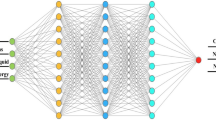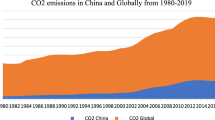Abstract
China and India are the largest coal consumers and the most populated countries in the world. With industrial and population growth, the need for energy has increased, which has inevitably led to an increase in carbon dioxide (CO2) emissions because both countries depend on fossil fuel consumption. This paper investigates the impact of energy consumption, financial development (FD), gross domestic product (GDP), population, and renewable energy on CO2 emissions. The study applies the long short-term memory (LSTM) method, a novel machine learning (ML) approach, to examine which influencing driver has the greatest and smallest impact on CO2 emissions; correspondingly, this study builds a model for CO2 emission reduction. Data collected between 1990 and 2014 were analyzed, and the results indicated that energy consumption had the greatest effect and renewable energy had the smallest impact on CO2 emissions in both countries. Subsequently, we increased the renewable energy coefficient by one and decreased the energy consumption coefficient by one while keeping all other factors constant, and the results predicted with the LSTM model confirmed the significant reduction in CO2 emissions. Finally, this study forecasted a CO2 emission trend, with a slowdown predicted in China by 2022; however, CO2 emission’s reduction is not possible in India until 2023. These results suggest that shifting from nonrenewable to renewable sources and lowering coal consumption can reduce CO2 emissions without harming economic development.

Source: Authors’ construct

Source: Authors’ construct

Source: Authors’ construct
Similar content being viewed by others
Data availability
Supplementary data to this article will be provided on request.
Abbreviations
- ANN:
-
Artificial neural network
- ARDL:
-
Autoregressive distributed lag
- BRICKS:
-
Brazil, Russia, India, China, and South Africa
- CO2 :
-
Carbon dioxide
- \({i}_{t}\) :
-
Input gate
- \({f}_{t}\) :
-
Forget gate
- FD:
-
Financial development
- GDP:
-
Gross domestic product
- GW:
-
Gigawatts
- kg:
-
Kilogram
- MSE:
-
Mean squared error
- MAPE:
-
Mean absolute percentage error
- ML:
-
Machine learning
- Mtce:
-
Metric tons carbon equivalent
- \({O}_{t}\) :
-
Output gate
- OPEC:
-
Organization of the Petroleum Exporting Countries
- ReLU:
-
Rectifier function
- LSTM :
-
Long short-term memory
References
Acheampong AO, Boateng EB (2019) Modelling carbon emission intensity: application of artificial neural network. J Clean Prod 225:833–856
Ağbulut Ü, Ceylan İ, Gürel AE, Ergün A (2021) The history of greenhouse gas emissions and relation with the nuclear energy policy for Turkey. Int J Ambient Energy 42:1447–1455. https://doi.org/10.1080/01430750.2018.1563818
Ahmad M, Zhao Z-Y (2018) Empirics on linkages among industrialization, urbanization, energy consumption, CO2 emissions and economic growth: a heterogeneous panel study of China. Environ Sci Pollut Res 25:30617–30632
Ahmad M, Jabeen G, Hayat MK et al (2020) Revealing heterogeneous causal links among financial development, construction industry, energy use, and environmental quality across development levels. Environ Sci Pollut Res 27:4976–4996
Ahmad M, Khan Z, Anser MK, Jabeen G (2021b) Do rural-urban migration and industrial agglomeration mitigate the environmental degradation across China’s regional development levels? Sustain Prod Consum 27:679–697
Ahmad F, Draz MU, Chandio AA, et al (2021) Investigating the myth of smokeless industry: environmental sustainability in the ASEAN countries and the role of service sector and renewable energy. Environ Sci Pollut Res 28: 55344–55361. https://doi.org/10.1007/s11356-021-14641-8
Ahmed K, Bhattacharya M, Shaikh Z et al (2017) Emission intensive growth and trade in the era of the Association of Southeast Asian Nations (ASEAN) integration: an empirical investigation from ASEAN-8. J Clean Prod 154:530–540
Ahmed Z, Zafar MW, Ali S (2020) Linking urbanization, human capital, and the ecological footprint in G7 countries: an empirical analysis. Sustain Cities Soc 55:102064. https://doi.org/10.1016/j.scs.2020.102064
Anser MK, Usman M, Godil DI, et al (2021) Does air pollution affect clean production of sustainable environmental agenda through low carbon energy financing? Evidence from ASEAN countries. Energy Environ 0958305X211007854. https://doi.org/10.1177/0958305X211007854
Aslam B, Hu J, Shahab S, et al (2021) The nexus of industrialization, GDP per capita and CO2 emission in China. Environ Technol Innov 23:101674. https://doi.org/10.1016/j.eti.2021.101674
Bandh SA, Shafi S, Peerzada M, et al (2021) Multidimensional analysis of global climate change: a review. Environ Sci Pollut Res 28: 24872–24888. https://doi.org/10.1007/s11356-021-13139-7
Baz K, Cheng J, Xu D, et al (2021) Asymmetric impact of fossil fuel and renewable energy consumption on economic growth: A nonlinear technique. Energy 226:120357. https://doi.org/10.1016/j.energy.2021.120357
BP (2020) Energy economics, Statistical Review of World Energy. https://www.bp.com/en/global/corporate/energy-economics/statistical-review-of-world-energy.html
Can M, Ahmad M, Khan Z (2021) The impact of export composition on environment and energy demand: evidence from newly industrialized countries. Environ Sci Pollut Res 28:33599–33612. https://doi.org/10.1007/s11356-021-13084-5
Chandio AA, Akram W, Ozturk I, et al (2021) Towards long-term sustainable environment: does agriculture and renewable energy consumption matter? Environ Sci Pollut Res 28:53141–53160. https://doi.org/10.1007/s11356-021-14540-y
Chiroma H, Abdul-kareem S, Khan A, et al (2015) Global warming: predicting OPEC carbon dioxide emissions from petroleum consumption using neural network and hybrid cuckoo search algorithm. PLoS One 10:e0136140. https://doi.org/10.1371/journal.pone.0136140
Cortez B, Carrera B, Kim Y-J, Jung J-Y (2018) An architecture for emergency event prediction using LSTM recurrent neural networks. Expert Syst Appl 97:315–324
Cramer W, Guiot J, Fader M et al (2018) Climate change and interconnected risks to sustainable development in the Mediterranean. Nat Clim Chang 8:972–980
Destek MA, Sarkodie SA (2019) Investigation of environmental Kuznets curve for ecological footprint: the role of energy and financial development. Sci Total Environ 650:2483–2489
Diaz D, Moore F (2017) Quantifying the economic risks of climate change. Nat Clim Chang 7:774–782
Dong K, Dong X, Dong C (2019) Determinants of the global and regional CO2 emissions: what causes what and where? Appl Econ 51:5031–5044
EIA (2020) India primary energy data in quadrillion Btu, analysis - Energy Sector Highlights, Energy indicators for India. https://www.eia.gov/international/overview/country/IND
EIA (2021) Rankings about energy in the World, Articles about energy around the world. https://www.eia.gov/international/overview/world
Fan Y, Liu L-C, Wu G, Wei Y-M (2006) Analyzing impact factors of CO2 emissions using the STIRPAT model. Environ Impact Assess Rev 26:377–395
Fan J, Zhou L, Zhang Y, et al (2021) How does population aging affect household carbon emissions? Evidence from Chinese urban and rural areas. Energy Econ 100:105356. https://doi.org/10.1016/j.eneco.2021.105356
Fang Z, Gao X, Sun C (2020) Do financial development, urbanization and trade affect environmental quality? Evidence from China. J Clean Prod 259:120892. https://doi.org/10.1016/j.jclepro.2020.120892
Farhani S, Shahbaz M, Ozturk I (2014) Department of Research–Ipag Business School Working paper, Coal consumption, industrial production and CO2 emissions in China and India. https://mpra.ub.uni-muenchen.de/id/eprint/50618
Fei L, Dong S, Xue L et al (2011) Energy consumption-economic growth relationship and carbon dioxide emissions in China. Energy Policy 39:568–574
Feng R, Xu H, He K, et al (2021) Effects of domestic solid fuel combustion emissions on the biomarkers of homemakers in rural areas of the Fenwei Plain, China. Ecotoxicol Environ Saf 214:112104. https://doi.org/10.1016/j.ecoenv.2021.112104
Gan T, Yang H, Liang W, Liao X (2021) Do economic development and population agglomeration inevitably aggravate haze pollution in China? New evidence from spatial econometric analysis. Environ Sci Pollut Res 28:5063–5079
Gao C, Tao S, He Y, et al (2021) Effect of population migration on spatial carbon emission transfers in China. Energy Policy 156:112450. https://doi.org/10.1016/j.enpol.2021.112450
Govindaraju VGRC, Tang CF (2013) The dynamic links between CO2 emissions, economic growth and coal consumption in China and India. Appl Energy 104:310–318
Gozgor G, Mahalik MK, Demir E, Padhan H (2020) The impact of economic globalization on renewable energy in the OECD countries. Energy Policy 139:111365. https://doi.org/10.1016/j.enpol.2020.111365
Hao Y, Chen H, Wei Y-M, Li Y-M (2016) The influence of climate change on CO2 (carbon dioxide) emissions: an empirical estimation based on Chinese provincial panel data. J Clean Prod 131:667–677
Huang Y, Shen L, Liu H (2019) Grey relational analysis, principal component analysis and forecasting of carbon emissions based on long short-term memory in China. J Clean Prod 209:415–423
Hwang J-H, Yoo S-H (2014) Energy consumption, CO2 emissions, and economic growth: evidence from Indonesia. Qual Quant 48:63–73
IEA (2021) Report extract Supply, Global coal production slumps in 2020, yet looks to increase in 2021. https://www.iea.org/reports/coal-2020/supply#abstract
Islam R, Abdul Ghani AB, Mahyudin E (2017) Carbon dioxide emission, energy consumption, economic growth, population, poverty and forest area: evidence from panel data analysis. Int J Energy Econ Policy 7:99–106
Ito K (2017) CO2 emissions, renewable and non-renewable energy consumption, and economic growth: evidence from panel data for developing countries. Int Econ 151:1–6
Jun W, Mughal N, Zhao J, et al (2021) Does globalization matter for environmental degradation? Nexus among energy consumption, economic growth, and carbon dioxide emission. Energy Policy 153:112230. https://doi.org/10.1016/j.enpol.2021.112230
Kalogirou SA (2000) Applications of artificial neural-networks for energy systems. Appl Energy 67:17–35
Khan MTI, Yaseen MR, Ali Q (2017) Dynamic relationship between financial development, energy consumption, trade and greenhouse gas: comparison of upper middle income countries from Asia, Europe, Africa and America. J Clean Prod 161:567–580
Kim J, Lim H, Jo H-H (2020) Do Aging and Low Fertility Reduce Carbon Emissions in Korea? Evidence from IPAT Augmented EKC Analysis. Int J Environ Res Public Health 17:2972. https://doi.org/10.3390/ijerph17082972
Kurniawan R, Managi S (2018) Coal consumption, urbanization, and trade openness linkage in Indonesia. Energy Policy 121:576–583
Lau E, Tan C-C, Tang C-F (2016) Dynamic linkages among hydroelectricity consumption, economic growth, and carbon dioxide emission in Malaysia. Energy Sources, Part B Econ Planning, Policy 11:1042–1049
Li Y (2020) Forecasting Chinese carbon emissions based on a novel time series prediction method. Energy Sci Eng 8:2274–2285
Li X, Chalvatzis KJ, Pappas D (2018) Life cycle greenhouse gas emissions from power generation in China’s provinces in 2020. Appl Energy 223:93–102
Li G, Wei W (2021) Financial development, openness, innovation, carbon emissions, and economic growth in China. Energy Econ 97:105194. https://doi.org/10.1016/j.eneco.2021.105194
Li L, Yang A, He X, et al (2020) Indoor air pollution from solid fuels and hypertension: A systematic review and meta-analysis. Environ Pollut 259:113914. https://doi.org/10.1016/j.envpol.2020.113914
Liddle B (2014) Impact of population, age structure, and urbanization on carbon emissions/energy consumption: evidence from macro-level, cross-country analyses. Popul Environ 35:286–304
Lin B, Xie C (2014) Reduction potential of CO2 emissions in Chin’s transport industry. Renew Sustain Energy Rev 33:689–700
Liu X, Bae J (2018) Urbanization and industrialization impact of CO2 emissions in China. J Clean Prod 172:178–186
Liu J-L, Ma C-Q, Ren Y-S, Zhao X-W (2020) Do real output and renewable energy consumption affect CO2 emissions? Evidence for selected BRICS countries. Energies 13:960. https://doi.org/10.3390/en13040960
•Liu H, Lei M, Zhang N, Du G (2019) The causal nexus between energy consumption, carbon emissions and economic growth: New evidence from China, India and G7 countries using convergent cross mapping. PLoS One 14:e0217319. https://doi.org/10.1371/journal.pone.0217319
Magazzino C, Mele M, Schneider N (2020) A machine learning approach on the relationship among solar and wind energy production, coal consumption, GDP, and CO 2 emissions. Renew Energy 151:829–836
Magazzino C, Mele M, Schneider N (2021) A machine learning approach on the relationship among solar and wind energy production, coal consumption, GDP, and CO2 emissions. Renew Energy 167:99–115
Mele M, Magazzino C (2020) A machine learning analysis of the relationship among iron and steel industries, air pollution, and economic growth in China. J Clean Prod 277:123293. https://doi.org/10.1016/j.jclepro.2020.123293
Meng G, Guo Z, Li J (2021) The dynamic linkage among urbanisation, industrialisation and carbon emissions in China: insights from spatiotemporal effect. Sci Total Environ 760:144042
Nawaz MA, Hussain MS, Kamran HW, et al (2021) Trilemma association of energy consumption, carbon emission, and economic growth of BRICS and OECD regions: quantile regression estimation. Environ Sci Pollut Res 28:16014–16028. https://doi.org/10.1007/s11356-020-11823-8
O’Neill BC, Liddle B, Jiang L et al (2012) Demographic change and carbon dioxide emissions. Lancet 380:157–164
O’neill BC, Dalton M, Fuchs R, et al (2010) Global demographic trends and future carbon emissions. Proc Natl Acad Sci 107:17521–17526
Ohlan R (2015) The impact of population density, energy consumption, economic growth and trade openness on CO 2 emissions in India. Nat Hazards 79:1409–1428
Ozturk I, Acaravci A (2013) The long-run and causal analysis of energy, growth, openness and financial development on carbon emissions in Turkey. Energy Econ 36:262–267
Parker RWR, Blanchard JL, Gardner C et al (2018) Fuel use and greenhouse gas emissions of world fisheries. Nat Clim Chang 8:333–337
Pervez H, Ali Y, Petrillo A (2021) A quantitative assessment of greenhouse gas (GHG) emissions from conventional and modular construction: A case of developing country. J Clean Prod 294:126210. https://doi.org/10.1016/j.jclepro.2021.126210
Rehman A, Ma H, Chishti MZ et al (2021b) Asymmetric investigation to track the effect of urbanization, energy utilization, fossil fuel energy and CO2 emission on economic efficiency in China: another outlook. Environ Sci Pollut Res 28:17319–17330
Rehman A, Ma H, Ahmad M, et al (2021a) Towards environmental Sustainability: Devolving the influence of carbon dioxide emission to population growth, climate change, Forestry, livestock and crops production in Pakistan. Ecol Indic 125:107460. https://doi.org/10.1016/j.ecolind.2021.107460
Roser HR and M (2019) Fossil Fuels, Fossil fuel consumption, Global fossil fuel consumption. https://ourworldindata.org/fossil-fuels
Salari M, Javid RJ, Noghanibehambari H (2021) The nexus between CO2 emissions, energy consumption, and economic growth in the US. Econ Anal Policy 69:182–194
Salim RA, Rafiq S (2012) Why do some emerging economies proactively accelerate the adoption of renewable energy? Energy Econ 34:1051–1057
Sarkodie SA, Strezov V (2019) Effect of foreign direct investments, economic development and energy consumption on greenhouse gas emissions in developing countries. Sci Total Environ 646:862–871
Sebri M, Ben-Salha O (2014) On the causal dynamics between economic growth, renewable energy consumption, CO2 emissions and trade openness: fresh evidence from BRICS countries. Renew Sustain Energy Rev 39:14–23
Shahbaz M, Omay T, Roubaud D (2018) Sharp and smooth breaks in unit root testing of renewable energy consumption. J Energy Dev 44:5–40
Shahzad SJH, Kumar RR, Zakaria M, Hurr M (2017) Carbon emission, energy consumption, trade openness and financial development in Pakistan: a revisit. Renew Sustain Energy Rev 70:185–192
Sheraz M, Deyi X, Ahmed J, et al (2021a) Moderating the effect of globalization on financial development, energy consumption, human capital, and carbon emissions: evidence from G20 countries. Environ Sci Pollut Res 1–19. https://doi.org/10.1007/s11356-021-13116-0
Sheraz M, Deyi X, Mumtaz MZ, Ullah A (2021b) Exploring the dynamic relationship between financial development, renewable energy, and carbon emissions: A new evidence from belt and road countries. Environ Sci Pollut Res 1–18. https://doi.org/10.1007/s11356-021-16641-0
Shi A (2003) The impact of population pressure on global carbon dioxide emissions, 1975–1996: evidence from pooled cross-country data. Ecol Econ 44:29–42
Sorge L, Neumann A (2019) The impact of population, affluence, technology, and urbanization on CO2 emissions across income groups
Swanborough J (2016) Paris climate agreement. here’s what world leaders have said World Economic Forum. In: WeForum. https://www.weforum.org/agenda/2016/10/quotes-from-world-leaders-on-the-paris-climate-agreement/. Accessed 6 Oct 2016
Tiba S, Belaid F (2021) Modeling the nexus between sustainable development and renewable energy: the African perspectives. J Econ Surv 35:307–329
Valadkhani A, Smyth R, Nguyen J (2019) Effects of primary energy consumption on CO2 emissions under optimal thresholds: evidence from sixty countries over the last half century. Energy Econ 80:680–690
Wang SS, Zhou DQ, Zhou P, Wang QW (2011) CO2 emissions, energy consumption and economic growth in China: a panel data analysis. Energy Policy 39:4870–4875
Wang S, Li C, Zhou H (2019) Impact of China’s economic growth and energy consumption structure on atmospheric pollutants: Based on a panel threshold model. J Clean Prod 236:117694. https://doi.org/10.1016/j.jclepro.2019.117694
Wang Q, Li S, Pisarenko Z (2020) Modeling carbon emission trajectory of China, US and India. J Clean Prod 258:120723
WHO (2021) Health topics, air pollution, deaths every year. https://www.who.int/health-topics/air-pollution#tab=tab_1
WorldBank (2020) World Population Prospects, Population, total.https://data.worldbank.org/indicator/SP.POP.TOTL
WorldBank (2021) World Bank open data, climate change, economy & growth, population, financial sector, energy & mining. https://data.worldbank.org/
Worldometers (2021) World Population, WORLD POPULATION SECTIONS, TOP 20 LARGEST COUNTRIES BY POPULATION. https://www.worldometers.info/world-population/
Yadav AK, Chandel SS (2014) Solar radiation prediction using artificial neural network techniques: a review. Renew Sustain Energy Rev 33:772–781
Yang Y, Zhao T, Wang Y, Shi Z (2015) Research on impacts of population-related factors on carbon emissions in Beijing from 1984 to 2012. Environ Impact Assess Rev 55:45–53
Yang F, Zhang S, Sun C (2020) Energy infrastructure investment and regional inequality: Evidence from China’s power grid. Sci Total Environ 749:142384. https://doi.org/10.1016/j.scitotenv.2020.142384
uz Zaman Q, Wang Z, Zaman S, Rasool SF (2021) Investigating the nexus between education expenditure, female employers, renewable energy consumption and CO2 emission: Evidence from China. J Clean Prod 127824. https://doi.org/10.1016/j.jclepro.2021.127824
Zhang H, Xia Y, Cao L, et al (2022) Associations between long term exposures to outdoor air pollution and indoor solid fuel use and depression in China. J Environ Manage 302:113982. https://doi.org/10.1016/j.jenvman.2021.113982
Zhang C, Tan Z (2016) The relationships between population factors and China’s carbon emissions: does population aging matter? Renew Sustain Energy Rev 65:1018–1025
Zheng Z, Chen H, Luo X (2019) Spatial granularity analysis on electricity consumption prediction using LSTM recurrent neural network. Energy Procedia 158:2713–2718
Zhu Q, Peng X (2012) The impacts of population change on carbon emissions in China during 1978–2008. Environ Impact Assess Rev 36:1–8
Zhu H-M, You W-H, Zeng Z (2012) Urbanization and CO2 emissions: a semi-parametric panel data analysis. Econ Lett 117:848–850
Zuo Z, Guo H, Cheng J (2020) An LSTM-STRIPAT model analysis of China’s 2030 CO2 emissions peak. Carbon Manag 11:577–592
Author information
Authors and Affiliations
Contributions
Mansoor Ahmed: conceptualization, data curation, methodology, software, writing original draft. Chuanmin Shuai: formal analysis, supervision, review, and editing. Maqsood Ahmed: methodology, software, visualization.
Corresponding author
Ethics declarations
Ethics approval and consent to participat.
Not applicable.
Consent for publication
Not applicable.
Competing interests
The authors declare no competing interests.
Additional information
Responsible Editor: Roula Inglesi-Lotz
Publisher's note
Springer Nature remains neutral with regard to jurisdictional claims in published maps and institutional affiliations.
Rights and permissions
About this article
Cite this article
Ahmed, M., Shuai, C. & Ahmed, M. Influencing factors of carbon emissions and their trends in China and India: a machine learning method. Environ Sci Pollut Res 29, 48424–48437 (2022). https://doi.org/10.1007/s11356-022-18711-3
Received:
Accepted:
Published:
Issue Date:
DOI: https://doi.org/10.1007/s11356-022-18711-3




